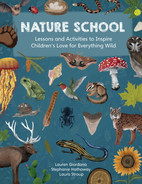Grasses as far as the eye can see, swaying back and forth in undulating waves with nothing to break the relentless wind. The grassland biome spreads across the temperate and tropical areas of Earth’s continents, usually between mountain ranges. Precipitation falls rather sparsely, and the soil caters to plants like big bluestem, red oats grass, and coneflowers.
Known for their rich soil and burrowing creatures, temperate grasslands are found in regions of North America and Europe. They often have mild summers and cold winters. Most of the rain falls in the spring and summer months, and snow falls in winter. Savannas are tropical grasslands with both wet and dry seasons. Tropical savannas are found on the continents of Africa, Australia, South America, and Asia.
Grasslands offer habitat for a diverse range of creatures on land and in the air. While grasslands cover about one-fourth of the world’s land, they look much different than they did throughout history. Because of the relatively flat, open land and workable soil, grasslands are an area used by people for agriculture. Farmers raise livestock and grow crops in these regions. Grasslands provide open spaces for animals, plants, and people to live and grow. In this chapter, we will discover the benefits of grasslands as well as the flora and fauna found in this important and beautiful biome
THE GRASSLAND ECOSYSTEM
Generally, grasslands are regions of level, open land in both temperate and tropical climates. Whether these ecosystems are called pampas, prairies, steppes, or savannas, grasslands are found throughout the world, and on every continent with the exception of Antarctica.
Temperate grasslands with rich soil are found in Europe, Asia, North America, South America, and Australia. Tropical grasslands are found close to the equator in Australia, Africa, Asia, and South America. The dry, dusty soil in this type of grassland is less fertile.
Types of Grasslands
While grasses are the most common plant found in this widespread biome, the type of plant life differs between climate zones and continents. Take a look at the variety of temperate and tropical grasslands found around the world.
The PRAIRIES of North America have some of the most fertile soil of any grassland. Tall, short, and midrange grass species dominate the landscape. Wildflowers also grow in abundance, adding color to the expanse of grasses. A grassland region found mostly in Argentina on the South American continent, the PAMPAS are home to grass species growing in warm and humid areas between the Atlantic coast and Andes Mountains. Pampas grass is a well-known species growing in this ecosystem. Spreading across Mongolia in Asia, the STEPPE REGION is a temperate, dry grassland that receives little precipitation throughout the year. The medium to tall grasses provide habitat and food for wildlife such as gazelles, pheasants, and grazing livestock run by herders through the region. SAVANNA habitat is located in tropical regions around the world, and it is home to unique plant and animal species. This tropical grassland tends to have distinct wet and dry seasons. Dense grasses and shrubs cover the ground, and some trees, such as eucalyptus and acacia, grow in savannas.
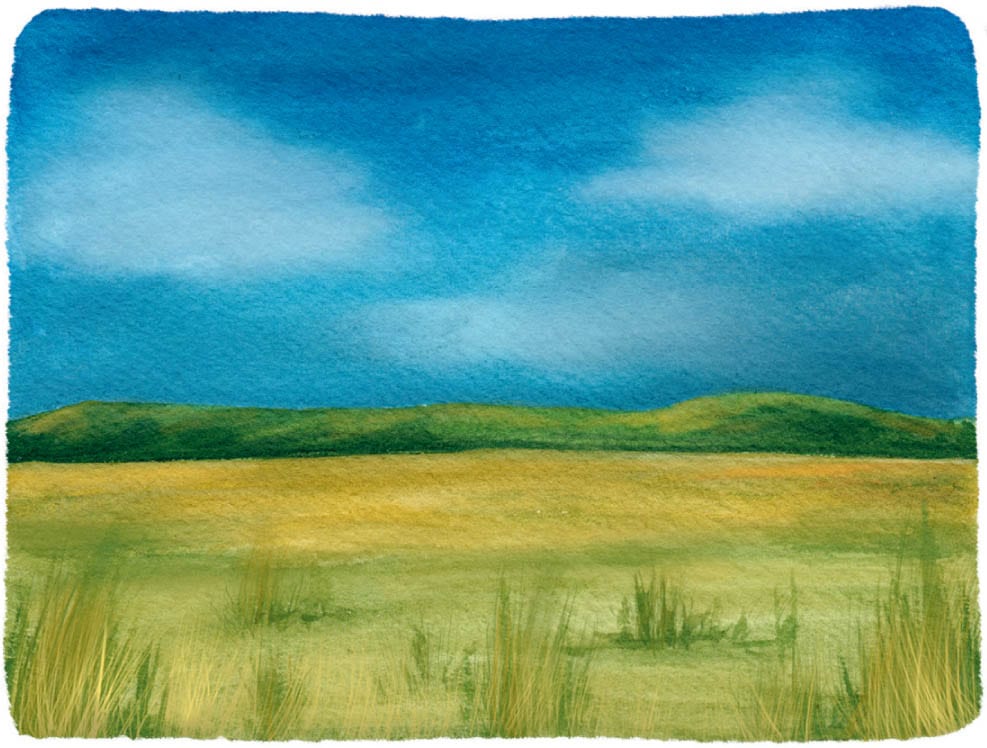
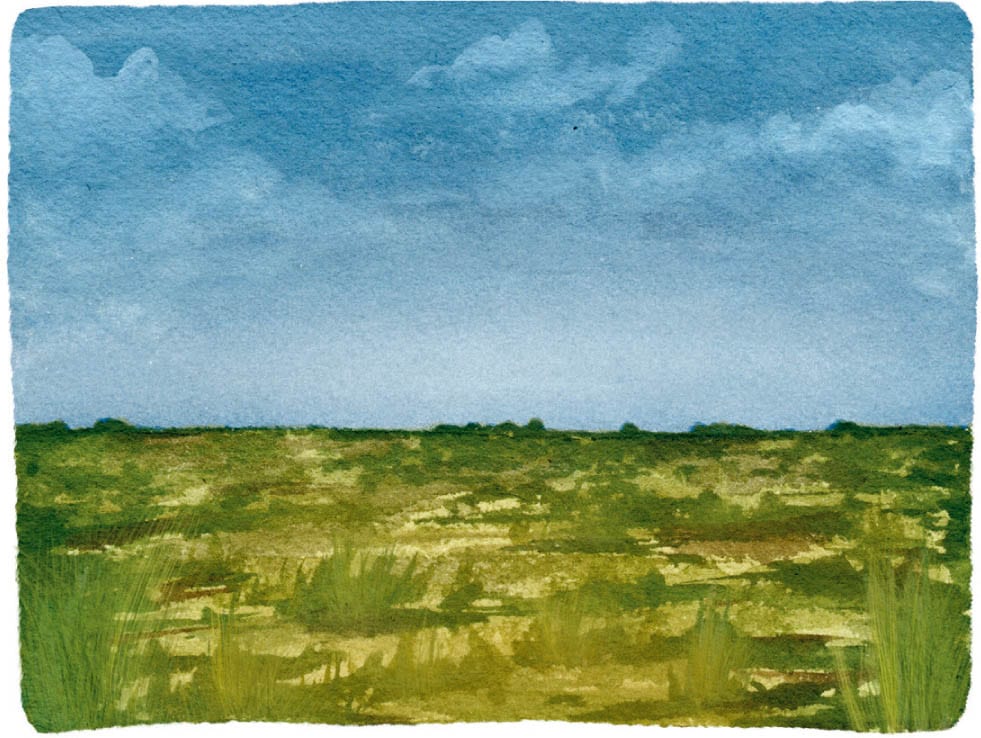

CLIMATE AND WEATHER
Overall, grasslands are dry with some precipitation in the form of rain or snow. Winds are relentless as stands of trees are few and far between. Depending on their location, temperatures can range from well below 32°F to around 86°F (0°C to 30°C).
Tropical grasslands, known as savannas, receive up to 50 inches (130 cm) of rain annually. But the rain comes all in one season, and then it is dry for the rest of the year. This weather pattern allows grasses and forbs to grow, but most tree species need water throughout the year to survive.
Temperate grasslands experience changing seasons. They receive precipitation throughout the year, with rain in spring and summer and snow in the frigid winter months. Taller grass species tend to grow in prairies, where they receive more water, and shorter grass species inhabit the drier steppe regions.
FUN FACT
Some grasslands help control flooding by soaking up water.
Grassland Fires
Wildfires sound scary and destructive, but they have a purpose and grassland plants and animals have adaptations for surviving these powerful natural events.
FUN FACT
Grasslands rely on fires to keep woody plants from growing and taking over.
Fires usually occur during the dry times of the year, and winds help propel them. Without underbrush to act as fuel, grassland fires burn quickly.
While the upper structures of grasses may burn, their roots and underground stems sit safely beneath the soil surface.
Grassland animals have adaptations like speed to run away from fires and some creatures burrow under the ground to escape.

FUN FACT
Grassland animal migrations are linked to the rainy season or annual flooding in certain regions. Dangerous storms and even tornadoes occasionally develop over these vast, open stretches of land.
Tornado Alley

Anatomy of a Tornado
Powerful storms rock the North American prairie during the summer months. When cold and warm air masses meet over the central part of the continent, violent rainstorms with lightning and tornadoes can be the result. Swirling funnels may form when the warm air currents rise upward as cold air is traveling downward. Winds in these tornadoes can blow over 250 miles per hour (400 kph).
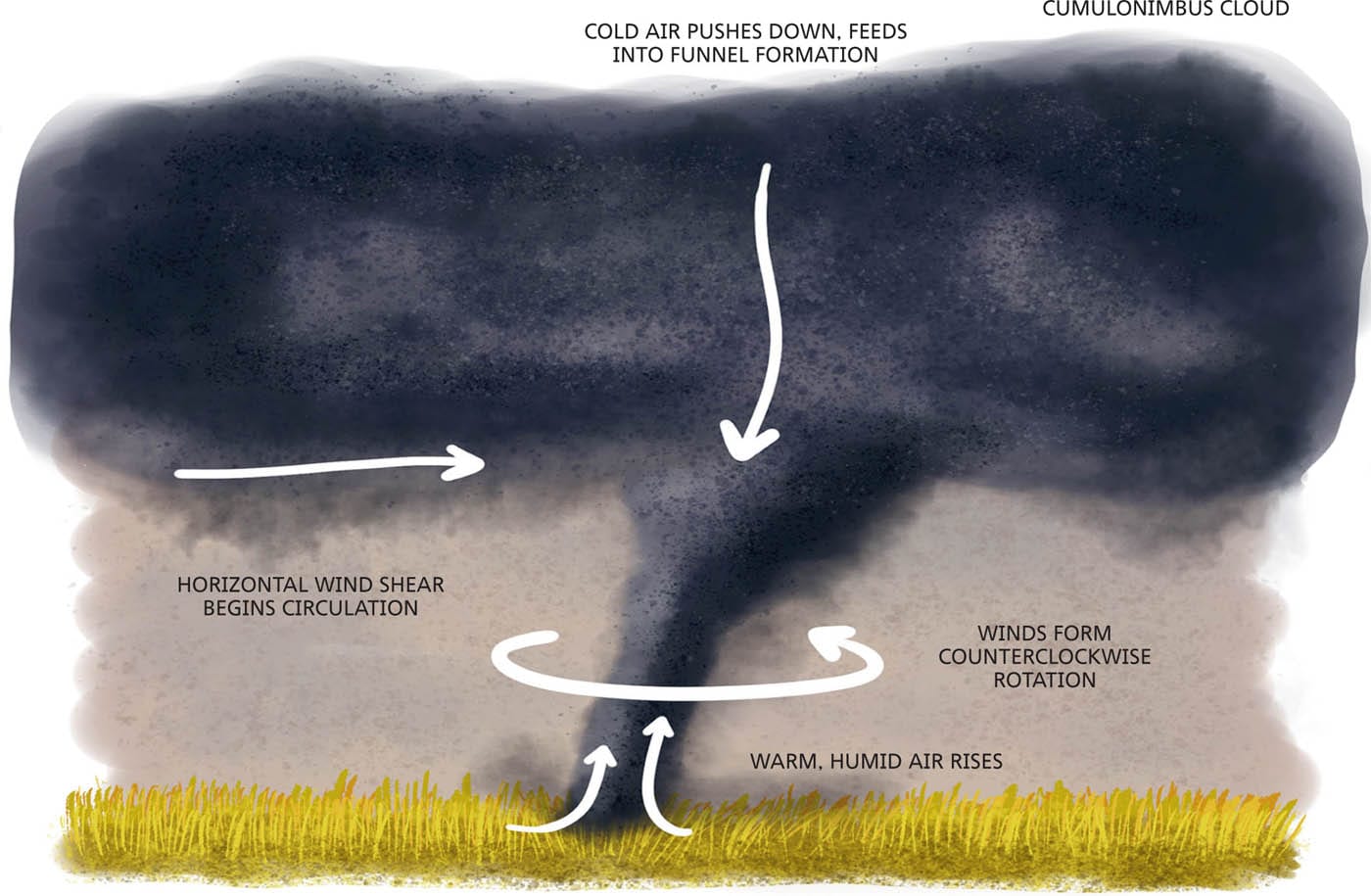
GRASS
Grasses belong to the family of plants known as Poaceae. Many grasses look similar to the untrained eye, but there are more than 10,000 unique species.
- Grass blades are the leaves of grass plants. They attach to the stem, or culm, at nodes.
- When left to grow, grasses develop a spikelet with flowers at the top of the culm for making seeds.
- Grasses are anchored by their roots, which grow deep into the ground to absorb water and nutrients.
- They hold on to soil, preventing erosion during windy and rainy conditions.
FUN FACT
Grasses are a major food source for grassland animals as well as humans. Foods like corn, oats, and wheat come from plants in the Poaceae family.
ANATOMY OF GRASS
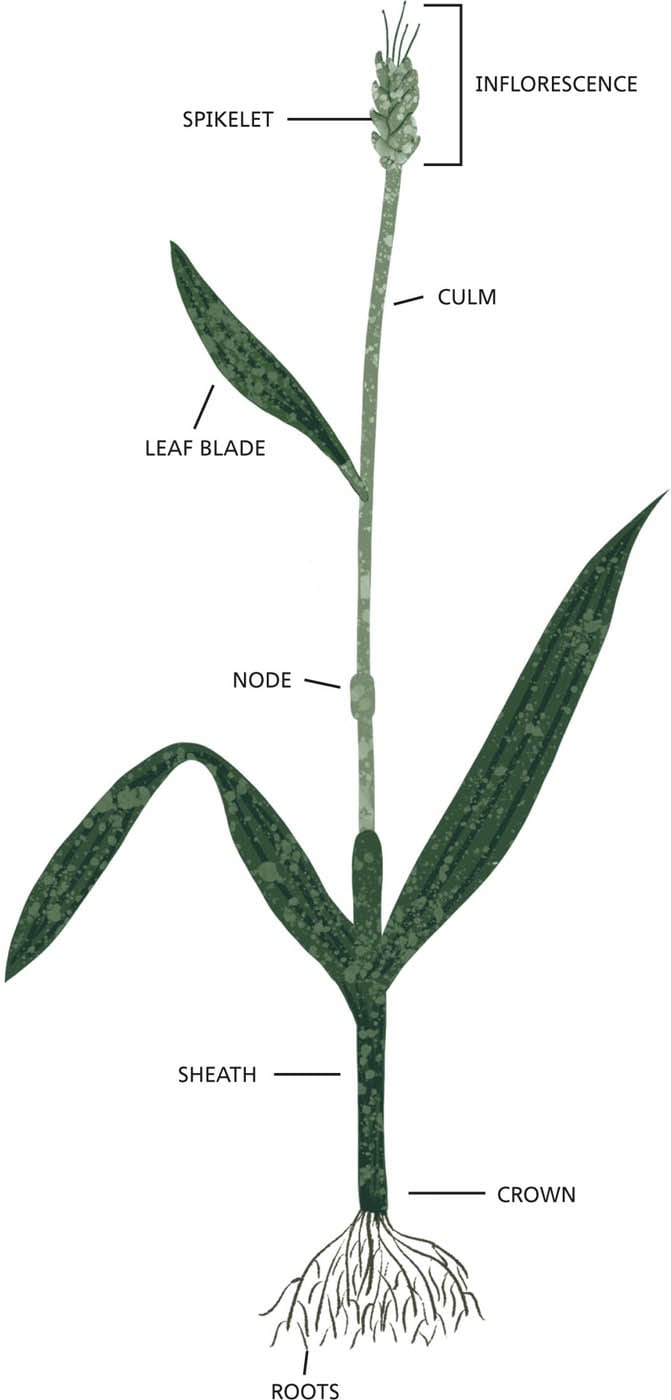
Grassland Soil

Soil in grasslands ranges from relatively dusty and thin to extremely fertile. Tropical savannas may have some humus on the top from decaying material, but it does not run deep. Savanna soils are usually dry and do not hold water effectively. Temperate grassland soils like those in the prairies drain well, but are also able to hold enough moisture for grass growth. Prairie soils are nutrient-rich, dark, and fertile.
FUN FACT
When plants die and the roots decay, they nourish the soil, helping to feed new plants.
The Carbon Cycle
Carbon is part of all living things, including plants inhabiting grasslands around the world. As grassland species grow, they remove carbon dioxide from the atmosphere to use during photosynthesis. Most extra carbon is stored in their roots underground, which remain in the ground even after the grasses have died. Eventually these roots decay and release carbon into the soil.
FUN FACT
Grassland soils are a storehouse for huge amounts of Earth’s carbon.

PLANTS
Grasses aren’t the only plants living in grasslands! Forbs are flowering plants with stems that die back each year. In grasslands, forbs are usually wildflowers, like sunflowers, goldenrod, and columbine. Although woody plants tend to be destroyed by grassland wildfires or damaged by drought conditions, some are able to survive.
FUN FACT
On the African savanna, acacia trees and baobabs are found, and eucalyptus trees are common in Australia’s grasslands.
Seed Dispersal
Plants have different methods for dispersing their seeds, so they can reach new areas.

WILLOWS use the wind to move their seeds, which are covered in cotton-like tufts.

SUNFLOWERS rely on animals to disperse their seeds when they eat them.

LUPINE ejects seeds from its pods in a method called ballistic seed dispersal.
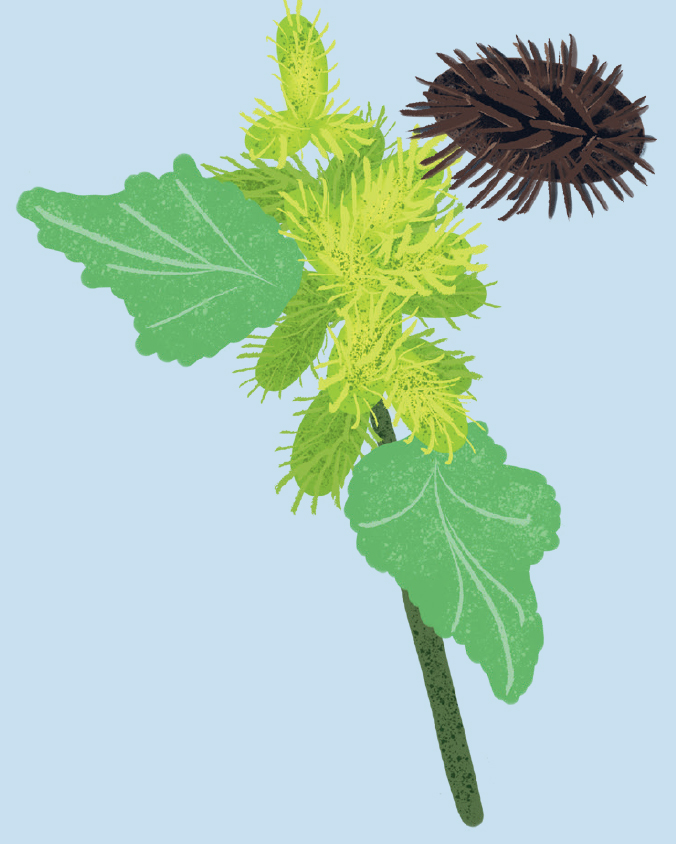
COCKLEBUR seeds attach themselves to animal fur and are carried to new locations.
PAMPAS GRASS is native to South American grasslands. It produces huge numbers of seeds that are distributed by the wind. It is adapted to withstand dry conditions and intense sunlight.
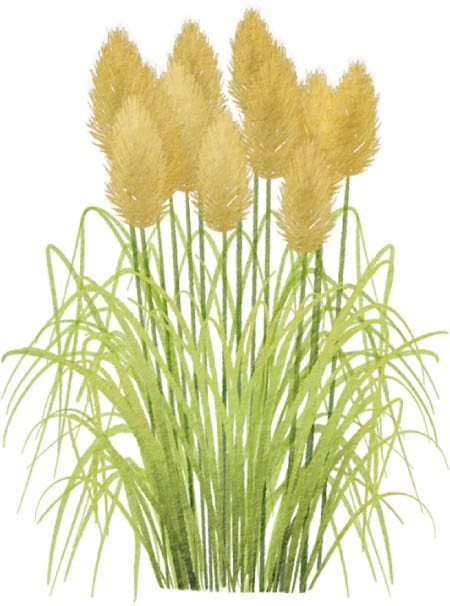
Temperate grasslands of Europe and Asia are home to the NARROW-LEAVED RATTLE. Its seeds grow inside a capsule and, when mature, make a rattling sound when the capsule moves.
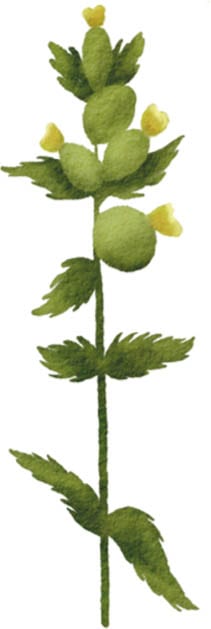
In fertile soil near water sources, ELEPHANT GRASS grows tall on the African savanna, reaching heights near 10 feet (3 m). This dense grass is eaten by elephants.
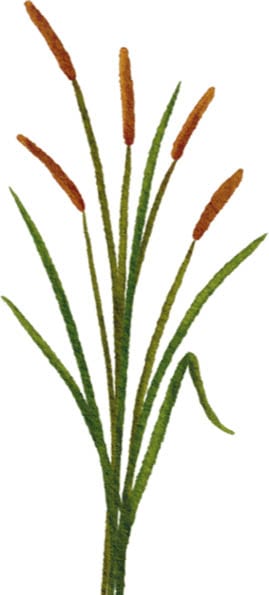
PURPLE CONEFLOWERS grow in North American prairies. They prefer moist soil, their petals are pinkish purple in color, and their seeds are eaten by seed-loving birds.

BERMUDA GRASS is native to southeast Africa but has been introduced in grasslands and agricultural areas around the world. Bermuda grass’s branching stolons and rhizomes help it spread quickly.

GOLDENROD has bright gold flowers that bloom in late summer on the prairies of North America. Bees and other pollinators rely on goldenrod nectar late in the season when few other flowers are blooming.

Sunflowers
Growing in the North American prairie, sunflowers need lots of sunlight to flourish. In fact, the large head of a sunflower rotates to follow the sun throughout the day.
FUN FACT
The head of a sunflower is actually a combination of hundreds to thousands of tiny flowers.

ANIMALS
Carnivore vs. Herbivore
Because prairies and savannas are dominated by grasses and forbs, herbivores like bison, zebras, pronghorn, and giraffes thrive there. They feed on plants, while grassland predators like lions, hawks, snakes, and wolves are carnivores that eat other animals. Some species such as coyotes and baboons are omnivores, eating both meat and plants.
FUN FACT
Grasslands are wide open areas with few hiding places. Many animals are fast and live in herds to escape predators. Others, like prairie dogs, burrow to hide underground.
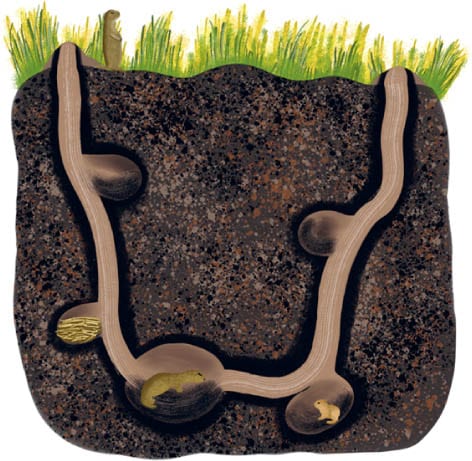
CARNIVORES

EARS CLOSE TO HEAD
SMALL EYES ON FRONT OF FACE
LARGE MOUTH TO CONSUME PREY
LONG, SHARP TEETH TO TEAR MEAT
STRONG JAWS
POWERFUL PAWS
SHARP CLAWS
HERBIVORES

DEFENSIVE HORNS
LARGE EARS PROTRUDE FROM HEAD
LARGE EYES ON SIDE OF HEAD
SMALL MOUTH AND JAWS
SMOOTH TEETH FOR GNASHING
LONG, SKINNY LEGS FOR RUNNING
SMOOTH, FLAT HOOVES
Grazing Animals
Herds of herbivores graze on low-growing vegetation of grasslands. Grazing is important to grasslands because they keep the grassland free of woody plants and ensure the grassland ecosystem survives.
FUN FACT
Grasses are able to withstand grazing because their growth points are low to the ground or under the surface.
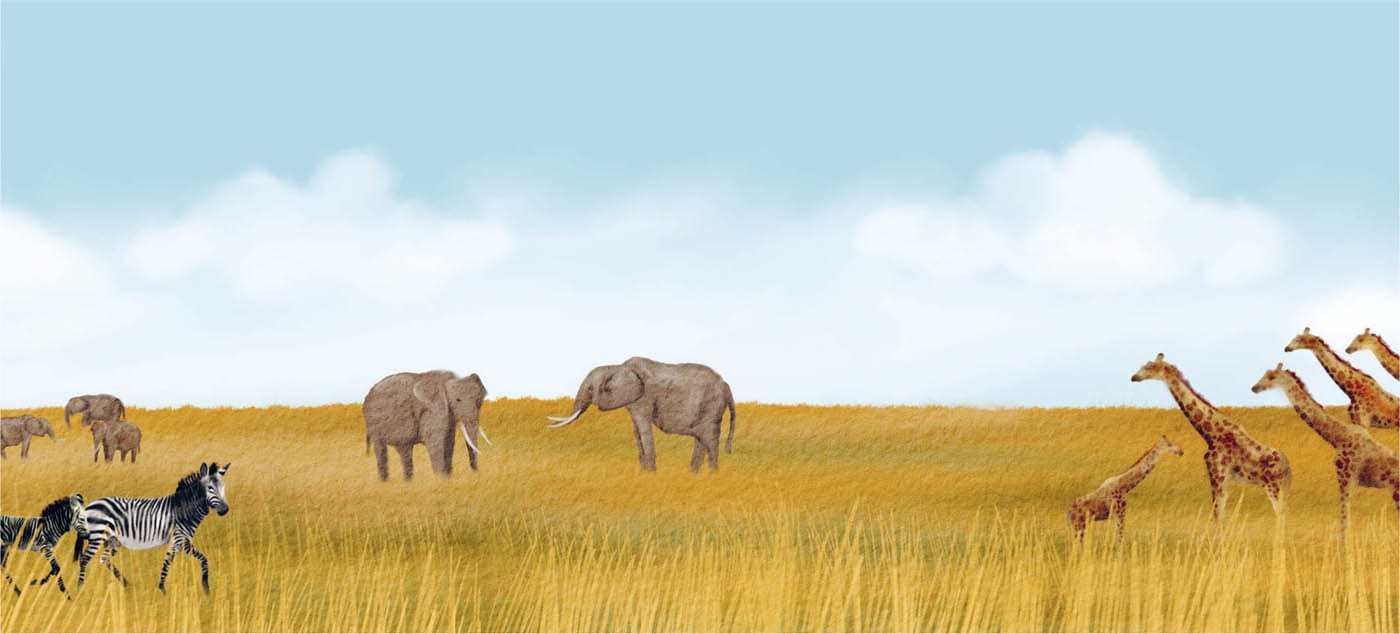
RED KANGAROOS are found throughout much of Australia and prefer open grassland areas. They eat grasses, forbs, and shrubs in the savanna, and they get most of their water from these foods.

Part of the antelope family, BLUE WILDEBEESTS inhabit the African savanna. They are large creatures, weighing up to 550 pounds (250 kg). Their huge herds migrate north during summer in search of food.

OLIVE BABOONS are native to the savannas of Africa, where they live in large groups. They are omnivores and feed on flowers, leaves, fruits, insects, and other small animals.

Found in Central and South America, GIANT ANTEATERS have no teeth but use their tongue to feed on ants. They do not destroy the ant nests while they feed, so they can use them for future meals.

PRAIRIE DOGS are rodents that earned the name prairie “dog” because of their shrill bark. They are native to the prairies of North America, where they live in large groups and build complex burrows.
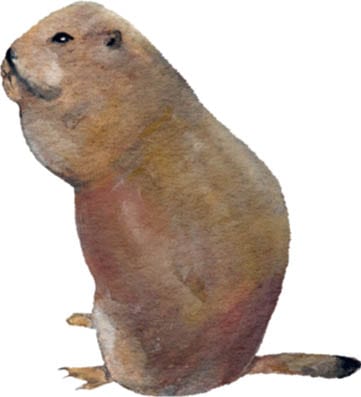
PRONGHORN live in herds in the grasslands of North America. Their eyesight allows them to spot threats from miles away, and they can run at speeds of nearly 60 miles per hour (100 kph).

Bison
American bison used to roam the North American prairie in large numbers but they are now a near-threatened species. Bison can run nearly 40 miles per hour (65 kph), and they stampede when frightened.
FUN FACT
American bison are the largest mammal in North America!

PREDATORS
Lions, cheetahs, jackals, wolves, coyotes, snakes, owls, hawks, and other predators are found in tropical savannas and temperate prairies and steppes. Many of these predators are sneaky, quick, and strong to catch prey, and some hunt in packs. They may have coloration to help them blend into the colors and patterns of grasslands to avoid detection.
Grassland Food Chain

FUN FACT
Grassland predators help keep herbivore herds healthy and plant communities from being overgrazed or overgrown.
Predator Adaptation: Stealth and Camouflage
Because their prey are runners and burrowers, and they are often in herds for protection, predators must strike quickly and with the element of surprise.
- Many predators use cryptic coloration to blend in with their surroundings, which allows them to ambush their prey.
- Cheetahs have dark spots covering their fur coat to break up their outline, which allows them to hide in the tall grass while they hunt.
- Lions and coyotes are similar colors to their surroundings, making them hard to see.

AFRICAN WILD DOGS hunt for small mammals on the open plains in sub-Saharan Africa. Using their sense of sight to find prey at dawn and dusk, they also work in packs to bring down larger prey.
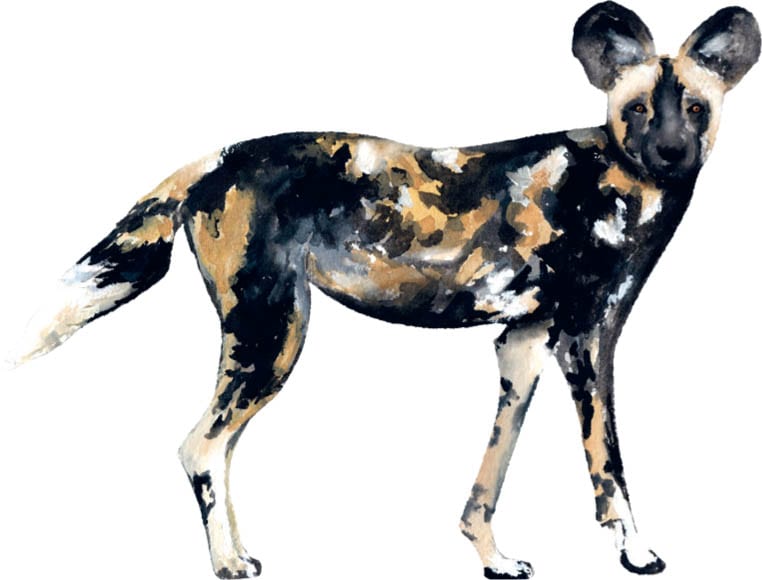
COYOTES’ sense of vision and hearing helps them find prey like rabbits and deer, and their speed helps them catch their food. Coyotes can run over 35 miles per hour (60 kph). Sometimes they hunt in packs.

STEPPE EAGLES make their home in grassland habitats of Asia and Africa. This large eagle species will prey on small mammals, other birds, and reptiles, and they will feed on carrion alongside vultures.

LIONS roam the African savanna, with coats the color of their surroundings. They have powerful bodies for killing large prey like zebras, and they have also been known to steal food from other predators.

Cheetahs
Cheetahs, the fastest land mammal, can run at speeds over 60 miles per hour (100 kph). Their bodies are adapted for moving quickly through the African savanna. The shape of their head and body as well as their long, flexible spine helps them run at top speeds.
FUN FACT
Cheetahs maneuver quickly by using their tail as a rudder.
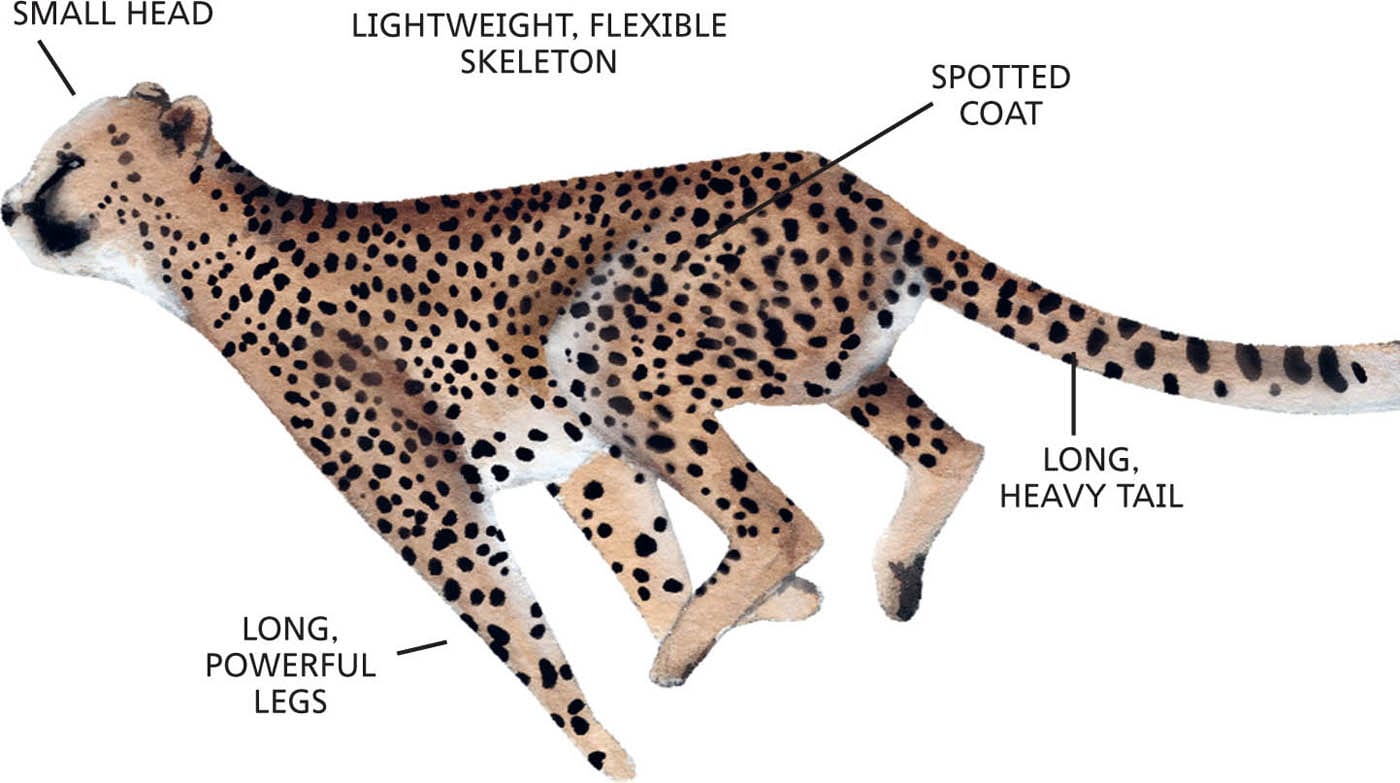
BIRDS
Grasslands make successful habitat for foraging, hunting, and nesting for a variety of bird species. Because many grassland birds make nests on the ground, within reach of predators, they must be camouflaged. They’re often colored in browns and grays with barred and striped feathers to blend in with their surroundings.
Types of Feathers
Wing feathers are long and have a shaft called a rachis running down the middle. Barbs extending from either side of the rachis hook together. They have a narrow “leading edge” that flies into the wind.
Tail feathers have a similar structure to wing feathers. Called rectrices, tail feathers are used for steering and stopping during flight and for balance.
Coverts are the feathers that overlap the wing feathers to keep the wings smooth.

Bird Life Cycle
When a baby bird hatches from an egg, it’s first called a hatchling. Fledglings have flight feathers and muscles for flying. Juveniles are birds that have left the nest and are on their own. They have dull plumage to help with camouflage. Juveniles become adult birds.

EGG
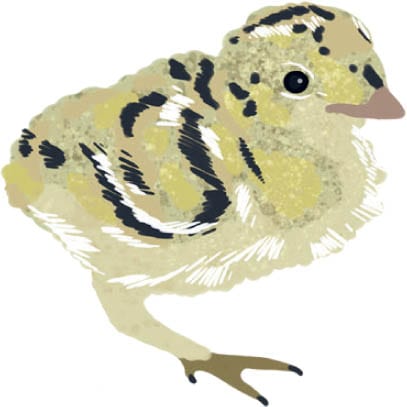
CHICK

ADULT
FUN FACT
Baby birds rely on their parents for protection, warmth, and food until they can leave the nest to feed themselves.
Native to Asia, COMMON PHEASANTS can fly short distances to escape from danger. Pheasants spend time on the ground foraging for seeds, berries, and insects.

A small, white raptor with black shoulders, the BLACK-SHOULDERED KITE is common in Australian grasslands. These birds hover above the ground while searching for prey such as rodents and insects.
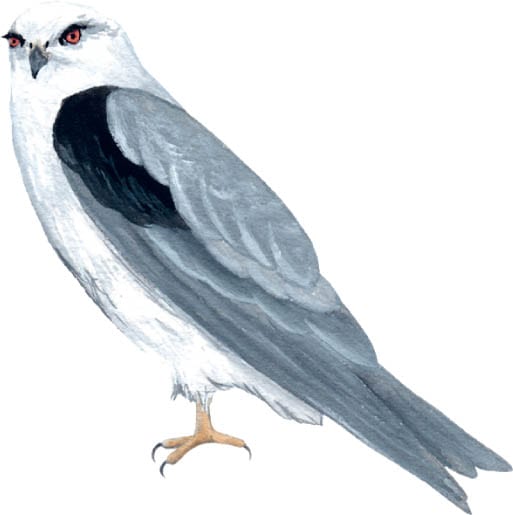
Found in Europe and parts of Asia, BLACK GROUSE live in open steppe habitats as well as other areas. They often feed on the ground, eating grasses, berries, and other vegetation.

BURROWING OWLS may dig their own burrows or nest in former prairie dog and ground squirrel homes. They live in open grasslands in North and South America, feeding on insects and small mammals.
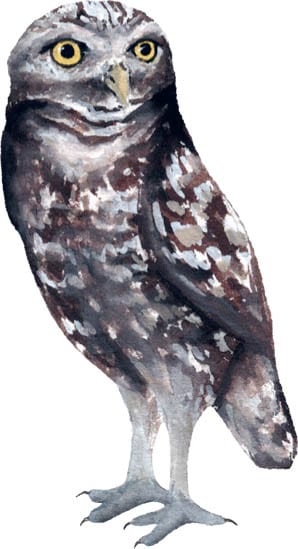
RHEAS walk through the pampas of South America looking for seeds and fruits and small animals to eat. These large, flightless birds flock together and may form herds with deer or guanacos in winter.

With a wingspan of more than 6½ feet (2 m), WHITE-BACKED VULTURES fly over the savannas of sub-Saharan Africa looking for carrion to eat. Several birds gather together for feeding and roosting.

Prairie Chickens
Prairie chickens are found in North America’s prairies. In the spring, groups of males gather together in breeding areas known as “leks” to dance for and call to females.
FUN FACT
Inflating their orange throat sac, males make a loud booming noise and tap their feet on the ground to attract females.

REPTILES AND AMPHIBIANS
With scales covering their body, reptiles can easily deal with the dry seasons in prairies and savannas. If they get warm, they can retreat to shade under plants or rocks. When they are cold, they can sun themselves in the open. Amphibians, on the other hand, must stay moist because they use their skin to take in oxygen. For amphibian species, burrowing in the soil, hiding under a rock, or living near a wetland or stream makes sense.
FUN FACT
While reptiles and amphibians are usually carnivores, looking for insects, small birds, and mammals to eat, they are also prey themselves. Large mammals such as coyotes as well as raptors like hawks and owls feed on these creatures in the grassland food web.
Reptile Life Cycle
When baby reptiles emerge from eggs, they are called hatchlings. Hatchlings look very similar to their parents, except for their small size and coloring.
FUN FACT
Most reptile hatchlings have to find their own food and water, and they must learn to hide or defend themselves from predators.
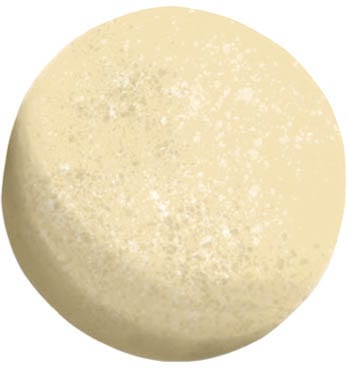
HATCHLING

EGG

ADULT
Found in the African savanna, AFRICAN COMMON TOADS are a large grassland amphibian that grows up to 5 inches (13 cm) in length. They feed on ants, termites, beetles, and other insects in their ecosystem.

PRAIRIE RATTLESNAKES are large snakes that live in North American prairies. Their coloration is similar to that of their surroundings, making them difficult to see. Prairie rattlesnakes eat prairie dogs, mice, and other small animals.

In the Australian temperate grasslands, the STRIPED LEGLESS LIZARD makes its home. Looking similar to a snake, this lizard’s stripes help it hide in thick grass tufts. It feeds on invertebrates such as spiders and caterpillars.
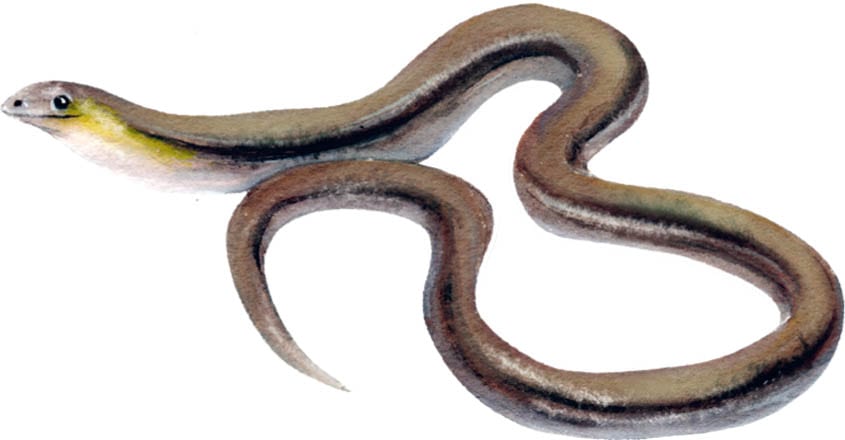
LEOPARD TORTOISES live in the savannas of Africa, where they feed on grasses. They are able to store water, an important adaptation for the dry season. They are crepuscular, meaning they are most active around dusk and dawn.

Great Plains Skink
The Great Plains skink is a lizard found in the temperate grasslands of North America. These lizards are eaten by larger animals like snakes and birds.
FUN FACT
Vegetation and rocks in the grasslands provide lizards with places to take shelter.
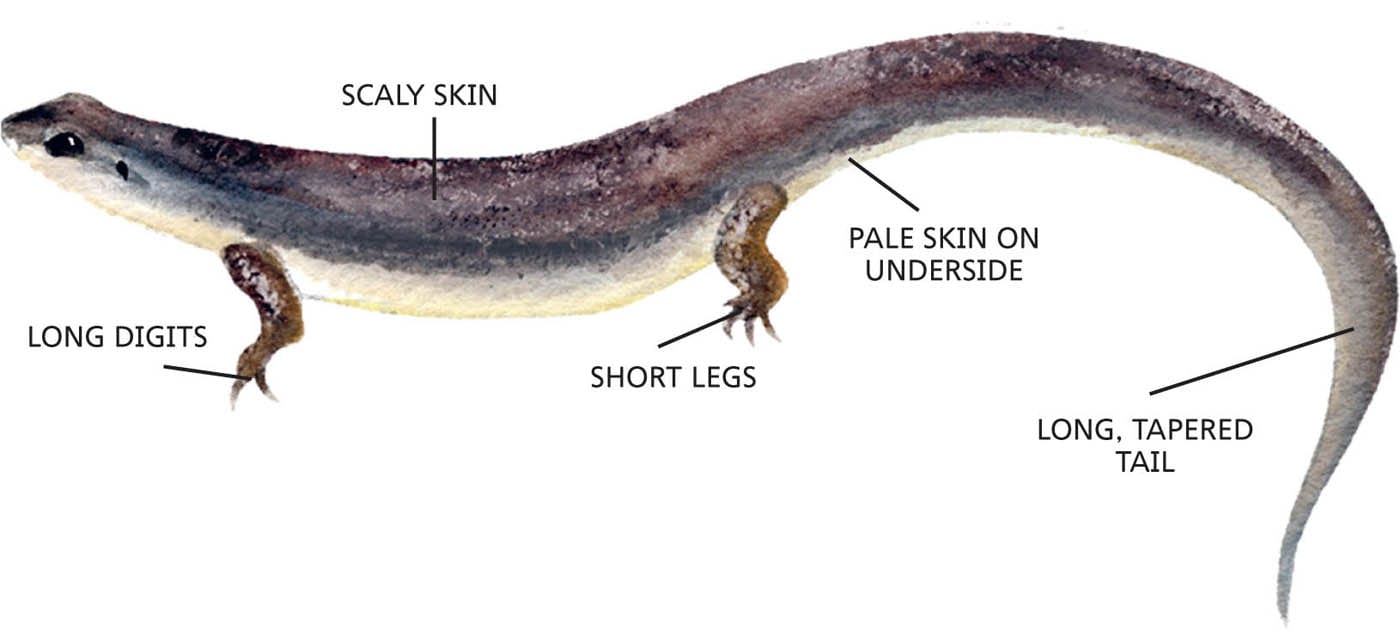
INVERTEBRATES
Invertebrates may be some of the smallest species in grasslands, but prairie and savanna ecosystems would not be the same without them. Invertebrates provide a rich food source for larger animals like songbirds and mammals and break down plant and animal matter, recycling nutrients into the soil. Ants, termites, and others excavate burrows in the ground and aerate the soil. And winged invertebrates such as bees and butterflies act as pollinators for grassland wildflower species.
FUN FACT
Invertebrates are the largest animal group found in grasslands around the world.

Anatomy of a Termite Mound
Grasshopper Life Cycle

EGGS
Female grasshoppers lay their eggs in the soil. When the eggs hatch, the nymphs look similar to adults except they do not have wings.

NYMPH
Nymphs feed on leaves and go through simple metamorphosis, growing larger until they molt, or shed, their outer layer. They will molt around five times before reaching adult size and are known as instars between sheds.
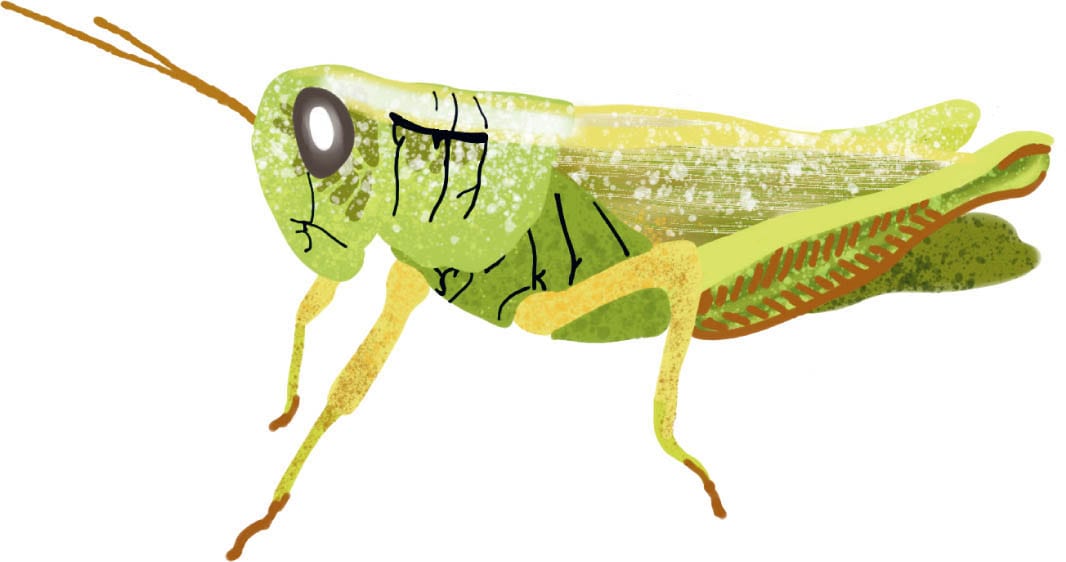
ADULT
After their final molt, grasshoppers have functional wings and are considered adults, or imagos.
GOLDENROD SOLDIER BEETLES are a flying beetle that feeds on and finds their mates among the prairie flowers in North America. These beetles may also feed on aphids and other plant pests.

EUROPEAN FIELD CRICKETS inhabit grasslands on the continent of Europe. They grow up to ¾ inch (2 cm) in length. Males of the species sit and sing at their burrow entrance to attract females.

EURASIAN GRASS SPIDERS live in grasslands across Europe. They make their webs aboveground and hide in a funnel within the web. When insects get stuck in their web, they run out of the funnel to collect their prey.

ACACIA ANTS inhabit acacia trees in the savanna of East Africa. The trees’ thorns have a hollow base in which the ants nest and drink nectar.
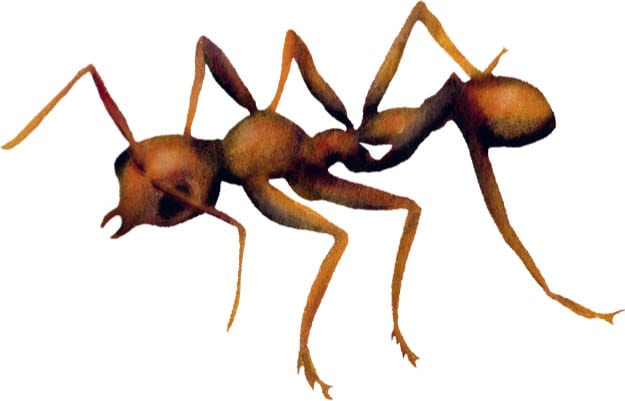
The COMMON BLUE BUTTERFLY, named for the male’s coloration, is often found in European grasslands. A fairly small species, their wingspan is around 1¼ inches (3 cm). Larvae are green, hairy caterpillars.

AUSTRALIAN PLAGUE LOCUSTS are found throughout the grasslands and open habitats of Australia. They often form swarms and destroy large areas of vegetation before migrating to new regions to feed.

Cicadas
Cicadas are a group of relatively large insects with big heads, noticeable eyes, and clear wings. Young cicadas dig into the ground, where they feed and grow over many years and eventually emerge as adults.
FUN FACT
There are more than 3,000 species found around the world.
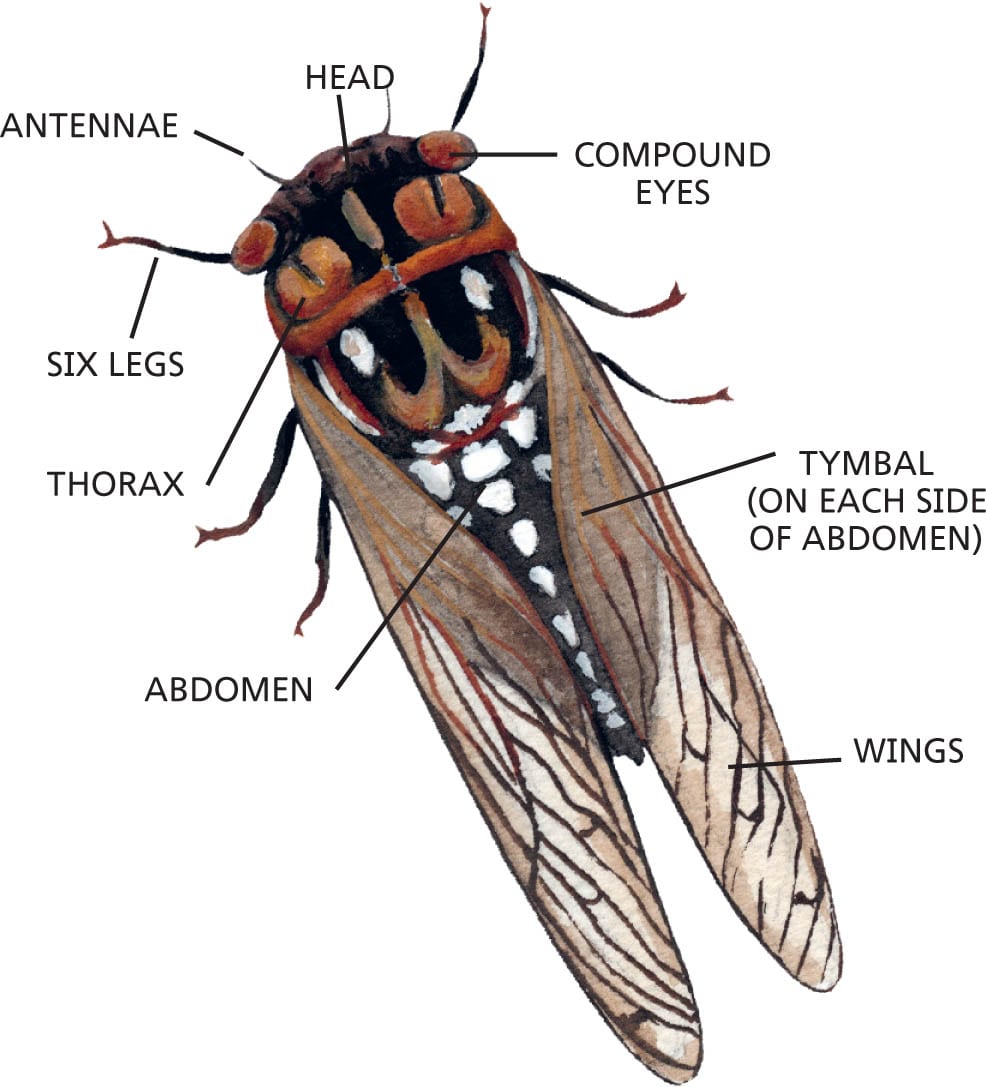
ACTIVITIES
Throughout this chapter, you have explored the grand grassland biome from the temperate regions to the tropics. We’ve learned about the animals and plants native to prairies, savannas, and steppes and studied the importance of each. See the grasslands in a more tangible way as you complete these hands-on projects.
Nature Journal
Nature journaling requires only a pencil and notebook. You can take colored pencils or a special journal with you if you prefer. Visit a nature center or natural area in a grassland ecosystem if you have one in your region. Alternatively, you could visit a park with a meadow or an open field or read a book about grasslands to choose a nature journaling topic. Choose one aspect of the grassland to journal about, whether it is a plant, an animal, or something else that catches your eye. Draw a picture of it, and/or write about it in your journal to describe your observations.
Build a Burrow
We have learned that grasslands are a popular place for burrowing animals to make their home. While you might not have the adaptations for digging a den in the prairie or pampas, you can make a burrow for yourself using items you have at home, like pillows, cushions, sheets, and blankets. Using these simple supplies and your imagination, construct a burrow in which you can fit. Model it after one of the animals you learned about in this chapter, or make an original.
Camouflage
As a defense, many animals use camouflage to blend in with their surroundings. Because there are few places to hide in the wide-open grassland, animal species living there often have stripes, are covered in shades of gray and brown, or have patterns that make them hard to see. Go on a nature walk to look for animals with good camouflage. Familiarize yourself ahead of time with animals you might see while you’re out and about, so you know where to look and what to look for. Even animals in the city may blend in with tree trunks, leaves, or buildings where they live or roost.

TORTOISE

RABBIT

CHEETAH

LIZARD
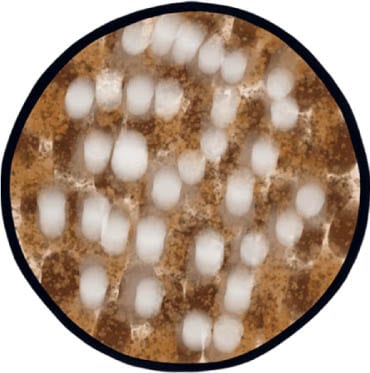
BURROWING OWL
Pressed Grasses and Wildflowers
Grasslands are full of grasses and wildflowers, both of which can be gathered and pressed to be used in craft projects or kept for collections. If you’re planning to pick them, make sure you have permission to do so. Otherwise, you can find some that have fallen to the ground and are no longer attached to the living plant. Flatter, smaller specimens usually work better than large, thick ones. And dry plants should be collected rather than plants wet with dew or rain.
- 1. After gathering your plants, place them between layers of parchment (or newspaper), making sure the flowers are not touching or overlapping.
- 2. Place the parchment inside a book. Close the book carefully, and stack more books or heavy items on top. This setup will help flatten and dry out the plants.
- 3. After two weeks, your plants should be ready! Place them on pages of a notebook for display, or make bookmarks, suncatchers, or notecards with them.

Growing Grass
Planting grass seed allows you to observe the growth of one of the most abundant types of plants on the planet! You may choose to plant grass seed outdoors in your yard, or you might want to plant it in a container to be kept indoors or outdoors. A small, clear container such as a glass jar would be ideal for watching growth both above and below the ground.
- 1. Fill the jar with potting soil nearly to the top, leaving about 1¼ inches (3 cm) of space.
- 2. Sprinkle a pinch of grass seed onto the soil. Then, lightly cover the seed with a scant layer of potting soil.
- 3. Water slightly so the soil is damp, and place the jar in a sunny window. Be sure to add water when needed to keep the soil moist but not soggy.
- 4. Keep a notebook nearby, so you can record your observations each day by drawing or writing about what you see.
- 5. You can even measure the grass each day once it begins to grow. When the grass becomes too large for the jar, it can be transplanted to a larger container or outdoors.

Tornado in a Bottle

Tornadoes occasionally occur in some grassland regions. These strong storms produce a powerful vortex that can destroy everything in its path. You can create your own swirling vortex in a bottle. You will need water, dish soap, glitter, and a plastic bottle with a narrow neck and tight-fitting lid (like a plastic soda or water bottle).
- 1. Fill the bottle about three-fourths full with water and then add a couple drops of dish soap.
- 2. Pick up a pinch of glitter and add it to the bottle before putting on the cap.
- 3. To create a vortex in the bottle, hold it by the neck out in front of you, turn it upside down, and twist it in a circular motion.
- 4. Once the water starts spinning, the glitter will help you see the vortex. Repeat as many times as you want to watch your tornado in a bottle.
Paint a Prairie
If you live in a region with a grassland ecosystem, you can go outside for inspiration. Otherwise, you can use books, a documentary, or your imagination. You’ll need paints, a paintbrush, and paper for this activity. Create a realistic or an abstract prairie landscape with your paints. Landscapes usually show a large scene from a natural area—grasslands in this case. Place your focus on either the background or the foreground in your painting, adding more detail to one and less to the other.
Did You Know?
Found mostly in North America, prairies are large expanses of grasslands that commonly have lots of wildflowers but very few trees. There are three main types of prairies, including tall grass, mixed grass, and short grass. Tall grass prairies are found in the eastern part of the North American grasslands where more rain falls, while short grass prairies are found further west in the rain shadow of the Rocky Mountains. Mixed grass prairies have features similar to both tall and short grass prairies, and they are found in between the other two regions.
